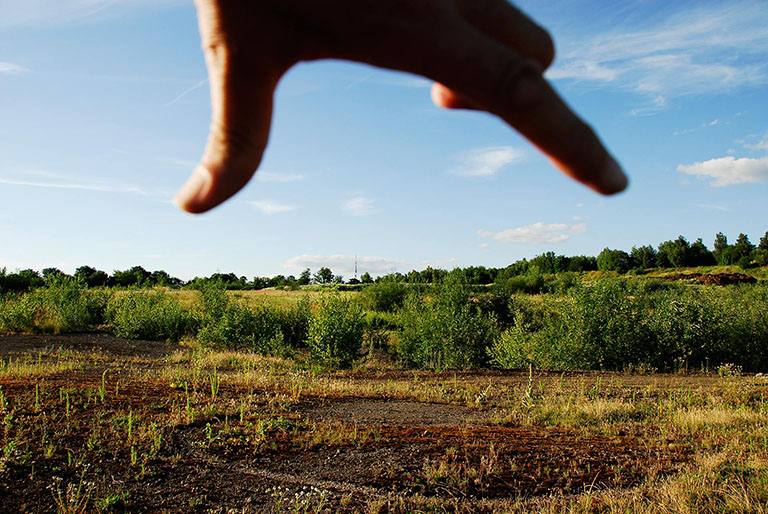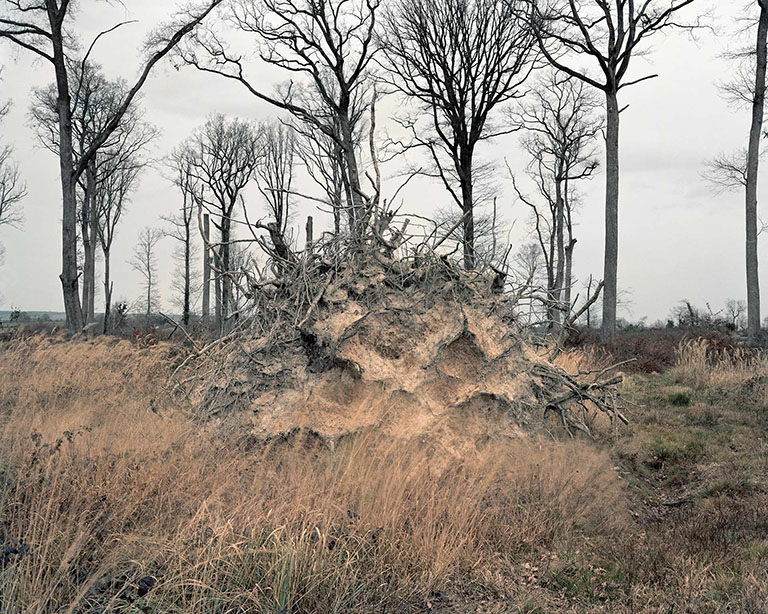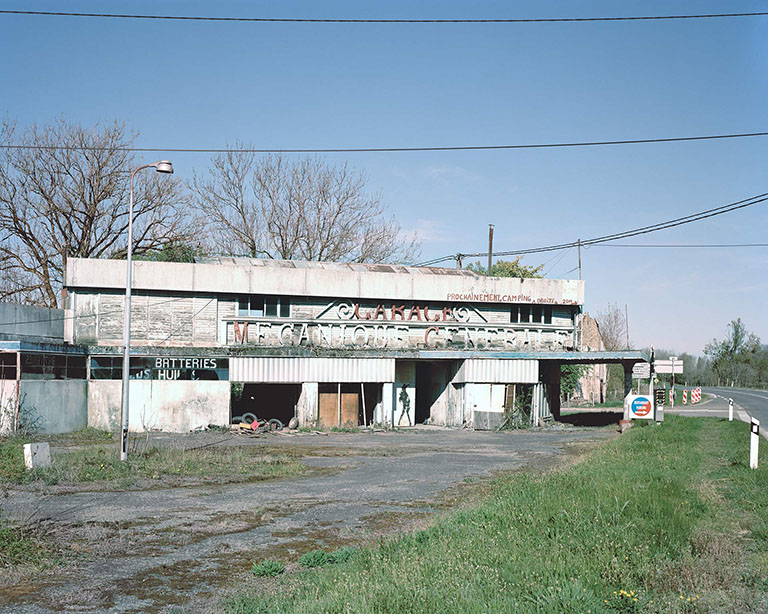
At the turn of this century, the "geographic tropism" of photographic creation is striking. Danièle Meaux, the author of the concept, goes so far as to speak of "geo-photography." Local and regional authorities offer photographers many opportunities as in-residence artists. At the same time, more and more personal initiatives, at times highly committed, seek to capture new facets of the physical landscape as well as the human, social, or economic. Whether it is to promote a local identity or to wander freely across the country, a single ambition emerges: to provide new ways of interpreting the French landscape. Thus, numerous artists try to rethink artistic commitment off the beaten track of photojournalism.
More often than not, the work undertaken entails an encounter between the identity of a territory and that of an author: the images attest as much to the author's passage through a territory as to the irruption of the landscape genre in the artistic trajectory of the photographer. We recognize easily the mellow chromatic style in the French countryside photographed by Thibaut Cuisset or the green and calm rural horizons of Xavier Zimmermann… as well as we recognize Corsica, in the fleeting and poetic fragments brought back by Dolorès Marat.
Visual research is evident in the collection of landscape markers such as the belvedere in the work of Mathieu Farcy, the observatories of Brigitte Olivier, or the pylons of Xavier Dauny. Other series, more obviously political in scope, turn these same markers into instruments of criticism: in this regard, the nuclear power plants of Jürgen Nefzger radically call into question our modern civilization. Another formal research method consists in deciding on a map the route to be taken so as to explore the tension between the concept and the terrain, as does, for example, Baptiste Schmitt, taking off in search of France's famous "Diagonale du vide" ("Empty Diagonal")—he re-names it the "Diagonale aride" ("Arid Diagonal")—along which numerous surprises await him.
As a prerequisite, as an exercise in style, or as the locus of political commitment, the landscape becomes ubiquitous in the photographic creation of the first years of the 21st century.

Elger Esser
Combray (Douville-sur-Andelle), 2010
Shaped by time and use, the wealth and complexity of the landscape are highlighted by the commission of the Mission photographique du Pôle Image Haute-Normandie: "Paysages, Territoires et Socialisation" ("Landscape, Territories and Socialization," Upper Normandy Image Center).
Elger Esser's helioengravings—subtle evocations of Impressionist paintings and of Proust's Remembrance of Things Past—appropriately illustrate the degree to which what we see is conditioned by history.

Le bar Floréal : Alex Jordan
Le crassier de Longwy en 1978

Le bar Floréal : Alex Jordan
Trente années après, le crassier a disparu et l’aciérie en dessous a été remplacée par... un terrain de golf
In 1978, during the violent strikes against the dismantlement of the Longwy mining region factories, Alex Jordan and André Lejarre, activist photographers and graphic designers with a keen social awareness, were on site. Thirty years later, ten photographers of the Bar Floréal collective (founded in 1985) return to Lorraine and take an inventory of this area, left by the wayside of economic development since the time of the strikes.

Dolorès Marat
Bastia. Le bateau de ma fenêtre d’hôtel

Dolorès Marat
Bastia. Les jumelles

Dolorès Marat
Bastia. La conversation

Dolorès Marat
Bastia. Le manège

Dolorès Marat
Corte. Les Michelines

Dolorès Marat
Bastia. Le retour
The works of photographers such as Massimo Vitali, Stéphane Couturier, or Dolorès Marat, with their easily recognizable styles, have been brought together by the Centre Méditerranéen de la Photographie (Mediterranean Center of Photography). The photos were commissioned with a view to highlighting all aspects of the Corsican territory. Dolorès Marat's characteristically blurred images, with their surge of emotion, perfectly mirror the beauty of the region.

Brigitte Olivier
Observatoire #1 (Arcachon), 2009

Brigitte Olivier
Observatoire #4 (Le wharf), 2016

Brigitte Olivier
Observatoire #5 (Cerbères), 2016
Water, air, horizon... in "Postes d'observation sur horizons atlantiques et méditerranéens" ("Atlantic and Mediterranean Horizon Observation Posts"), Brigitte Olivier's approach is contemplative. Her circular framing, suggesting the watchman's telescope, magnifies the minimal horizon, perfectly centered, to reveal over the days and nights the infinite variations of light and of matter, at times the one melting into the other.

Xavier Dauny
Col du Lautaret (Hautes-Alpes), mai 2002

Xavier Dauny
Vière, Prunières, D 409 (Hautes-Alpes), septembre 2002

Xavier Dauny
La Salle-les-Alpes, RN 91 (Hautes-Alpes), septembre 2002

Xavier Dauny
Vière, Prunières, D 409 (Hautes-Alpes), septembre 2002
The pylons of Xavier Dauny place an emphasis on history as the territory undergoes modernization. Going beyond the usual discourse on visual pollution, Xavier Dauny brings out the sculptural character of the pylon. He transforms the systematic and standardized character of this metallic construction into a musical variation, shifting our perspective on these installations.

Baptiste Schmitt
Avioth (Meuse) / Bunker, 2014

Baptiste Schmitt
Saint-Amand-Montrond (Cher) / Jour de tempête, fortes rafales de vent, 2013

Baptiste Schmitt
Forêt de Tronçais (Allier) / Cette forêt abrite les plus vieux chênes de France, 2013

Baptiste Schmitt
Woinic (Ardennes) / 10 mètres de haut et 15 mètres de long, emblème de la région des Ardennes, 2014

Baptiste Schmitt
Langres (Haute-Marne) / fin d’après-midi printanière, 2014

Baptiste Schmitt
Sommepy-Tahure (Marne) / Ce monument-ossuaire abrite les restes de dix mille combattants tombés sur le front de Champagne, 2014

Baptiste Schmitt
Fayl-Billot (Haute-Marne) / Bordure de la Diagonale, 2014

Baptiste Schmitt
Commercy (Meuse) / Hôtel La Madeleine, 2014

Baptiste Schmitt
Aire de la Guye (Saône-et-Loire), 2013-2014
In "La diagonale aride" ("Arid Diagonal"), Baptiste Schmitt expresses a preference for images that reflect the rural desertification found in the geographical region that stretches from the Ardennes to Cantal at the foot of the Massif central. Hiking 8 to 12 km a day allowed him to discover surprising and incongruous monuments and to bring to light numerous unknown curiosities.

Bertrand Stofleth
Villeneuve, lac Léman, piscine communale Les Marines, 2013
Bertrand Stofleth's "Rhodanie" captures little sketches, melancholic or comic, highlighting the incongruous constructions and uses of the space along the banks of the Rhone River, from its source in Switzerland to its mouth in the Mediterranean.

Raymond Depardon
Région Lorraine, département de la Meuse, Commercy, 2007
The intention of embracing the French territory in its entirety sometimes becomes an undertaking of such major proportions that each of the panoramas of mainland France resembles a monograph—of the author as of the country. One of the most striking examples is Raymond Depardon's "La France des sous-préfectures" ("The France of Sub-prefectures"), which transports us to a country of a bygone time, rich with clichés of another era.

Gilles Leimdorfer
Place de la Concorde

Gilles Leimdorfer
Camembert, Livarot et Pont-l’Évêque
In his "Mythologies" Gilles Leimdorfer "travels through our common places", as he puts it, and crisscrosses France from Place de la Concorde to Camembert. Surveying an imaginary France, he takes paths that wander away from our national mythology. Born of the need to confront his dream France with its reality, the series aspires to be "a journey from a France that might not exist to a France of today."

Thibaut Cuisset
Sans titre (La Margeride, Lozère), 2010

Thibaut Cuisset
Sans titre (Chouzy-sur-Loire, Loir-et-Cher), 2010
For years, shunning the facileness of the picturesque, Thibaut Cuisset has turned his attention to the French countryside. A serenity of approach as well as a very refined treatment of light contribute to producing a soft and delicate vision of the upheavals of the rural world.

Xavier Zimmermann
Nº 9, 2000-2005

Xavier Zimmermann
Nº 11, 2000-2005
Xavier Zimmermann's series, "Paysages français" ("French Landscapes"), groups together extremely pictorial views of meticulous composition, in which vast monochrome skies overhang narrow strips of rural territory at the edges of cities. Fields and forests literally become formal, French-style gardens.

Jürgen Nefzger
Centrale nucléaire de Penly (Seine-Maritime), 2003

Jürgen Nefzger
Centrale nucléaire de Nogent-sur-Seine (Aube), 2003

Jürgen Nefzger
Site nucléaire du Tricastin (Drôme), 2003
Jürgen Nefzger crosses through the industrial and tourist zones that disfigure a France immersed in the flow of an alienating mass consumption. Pushing the critique even further, the series "Fluffy Clouds" plays on the contrast between the carefree bathers, anglers, or strollers and the omnipresence of the troubling silhouette of the nuclear power plants in the background.

Bertrand Meunier
Danseurs couple : salon de danse, Vierzon, mars 2009

Bertrand Meunier
Portrait majorettes, mère et fille, Bray-sur-Somme, juillet 2010
Ultimately, it is the sense of belonging that Bertrand Meunier works on in his series "Je suis d'ici" ("I'm from here"), confirming the passage from the countryside of his roots, to notions of country, or even to a sense of uprootedness. He returns to question the places of his childhood which, appropriating his words, "won't leave [him] alone and push [him] to continue [his] multiple and subjective path to find [his] 'answers.'"

Bertrand Meunier
Pavillon, Vierzon, mars 2011